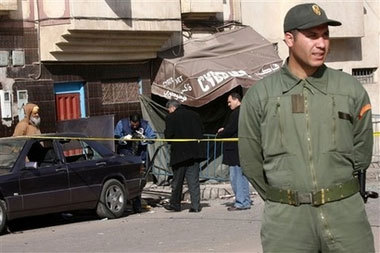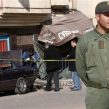
Morocco’s Multi-Pronged Counterterrorism Strategy
Publication: Terrorism Monitor Volume: 7 Issue: 13
By:

This May marks the sixth anniversary of the deadly night of suicide bombings in Casablanca. The attacks, characterized by many as Morocco’s 9/11, took the lives of 33 innocent victims, while the attackers, hailing from the slums of Sidi Moumen, lost 12 of their own. Since that dark night, Moroccans have been led by King Mohammad VI on a path to cleanse the kingdom of the scourge of violent extremism. In pursuit of this goal, Morocco has embarked on a multi-pronged strategy to combat terrorism and thwart the efforts of the Algerian-based Al-Qaeda in the Islamic Maghreb (AQIM) to widen the theater of regional jihad in North Africa. The strategy is comprehensive in nature and sets out multiple objectives which illuminate Morocco’s position as a beacon of hope in the often tumultuous North African political environment.
Judicial Actions
Morocco’s judiciary remains a key player in the country’s counterterrorism arsenal and routinely coordinates its efforts with counterparts abroad. This is particularly true in cases involving the ongoing prosecution of individuals suspected of having ties to the 2003 Casablanca bombings and the attacks on Madrid’s transportation system the following year. The Moroccan Islamic Combat Group (Groupe Islamique Combattant Marocain – GICM), suspected by some to have played a role in one or both of the attacks, may be defunct, but the group’s legacy lives on in the courts. In early March, an appeals court in Sale sentenced GICM member Hassan al-Haski to ten years in prison for his involvement in the 2003 Casablanca bombings. He was charged with “forming a criminal gang to prepare and commit terror attacks aimed at seriously undermining the public order by means of terror and violence” (Maghreb Arab Presse, March 2). Hassan is one of three al-Haski brothers, all of whom have been affiliated with transnational terrorism. He was captured by Spanish authorities in the Canary Islands in 2004 after leading authorities on a month-long manhunt in the wake of the 2004 Madrid bombings (Lukor.com [Granada], December, 2004).
An arrangement between Moroccan and Spanish authorities allowed Hassan al-Haski to be temporarily transferred to Morocco to stand trial. He has now been returned to Spanish custody to continue serving a 14-year sentence for his involvement in the Madrid attacks (Assabah, February 26; AFP, April 3). One week earlier the Moroccan court sentenced Saad al-Husseini, an alleged “key plotter” in the Casablanca attacks, to 15 years in prison. In a related move, the court also handed out sentences ranging from three to eight years imprisonment to 17 of his co-conspirators (Maghreb Arab Presse, March 2). In addition to prosecuting individuals involved in the 2003 Casablanca attacks, the terrorist tribunal in Sale recently convicted 29 individuals for belonging to a terrorist organization. The prosecution stated the men were members of AQIM and to varying degrees had been active in planning terror attacks, inciting violence and holding unauthorized meetings (AFP, April 17).
While the prosecution of terror suspects has grabbed headlines, Morocco’s judiciary has also been extending a carrot to detained Salafi-Jihadi detainees. The Moroccan Human Rights Dignity Forum Association recently invited Saudi and Egyptian clerics to speak at an international conference on April 24th. The selected clerics were previously involved in leading spiritual efforts to rehabilitate jailed Islamists (Assabah, April 20). It is not clear which specific cases they have been involved in and the Saudi program has suffered some significant setbacks (see Terrorism Monitor, April 10). Egypt, however, has had notable successes in rehabilitating former Islamic Group (IG) members, including the high profile recantation of militancy by former Egyptian Islamic Jihad and al-Zawahiri associate Sayyid Imam (a.k.a. Dr. Fadl) (see Terrorism Monitor, December 10, 2007; Terrorism Focus, April 30, 2008). It is too early to tell if we can expect similar “confessions” to arise from Moroccan prisons. Rehabilitation programs, Islamist or otherwise, are never a silver bullet and are often most effective with those who are not yet fully committed to their cause. Nonetheless, the inclusion of Saudi and Egyptian representatives in the early stages of developing a prison-based rehabilitation program for jailed Islamists is a sign that Moroccan authorities are taking the initiative seriously and hoping to replicate and perhaps build upon the past successes of similar programs abroad.
Advanced Military Training
The threat from AQIM has been largely rhetorical, inasmuch as available information does not suggest there have been any substantive AQIM-led plots inside Morocco. On the other hand, an increase in military training and regional cooperation has undoubtedly played a hand in maintaining a secure environment. Three specialized units have recently been established in the Moroccan Army. The units were formed to focus on illegal immigration, terrorism and drug smuggling – three interwoven plagues currently confronting Morocco. The staffing for each unit reportedly calls for 140 soldiers and 13 officers, led by a colonel. American and French forces have provided specialized training to the units (Assabah, March 12). The initiative appears to be a step towards diversifying the ranks of the Moroccan Armed Forces by adding advanced training and creating elite units capable of combating the threats facing the kingdom after making the transition to an all volunteer force in 2006 (see Terrorism Monitor, February 21, 2007).
Separately, the Moroccan military conducted a large scale combined arms exercise this April near Oum Driga. The maneuvers involved over 2,000 troops operating both on the ground and in the air and were designed in part to test the interoperability of the services and their newly acquired U.S. and European weapons systems (Assabah, April 9). Although it remains unstated, a possible objective of the exercise may have been a show of force aimed at Algeria in the wake of recent protests by the Algerian-based Polisario and its perennial effort to draw attention to its demands for an independent Western Sahara. In addition to the newly acquired Western military equipment, Morocco is rumored to be in negotiations with Russia to purchase Boyevaya Mashina Desanta (BMD) armored vehicles similar to those recently delivered to neighboring Algeria (Assabah, April 20). If true, this may suggest Morocco is engaging in an unofficial arms race with neighboring Algeria – an historic rival.
Regional Cooperation
The 28th meeting of the Arab Maghreb Union Ministerial Council was held in Tripoli on April 19. Regional integration is one of the stated aims of the ministerial council, although political obstacles have proved to be impediments to measurable progress (al-Jazeera, April 19). Substantive discussions on regional security and cooperation are more likely to gain traction at the working level between the nations’ various security services. Reports from the February 23 meeting of the heads of the Maghreb’s security agencies in Nouakchott indicate there is now recognition of the threat AQIM poses to regional stability. The agency heads acknowledged the threat not only to infrastructure targets within their respective countries, but also the impact terror attacks could have on the flow of commerce and migration throughout the Maghreb (Agence Mauritanienne d’Information, February 23).
Slum Eradication
The revelation that the assailants in the May 2003 Casablanca bombings hailed from the city’s vast slums gave momentum to the belief that poverty is responsible for terrorism. Nevertheless, more complex socio-economic factors have likely contributed to fostering an environment in which the socially and economically less fortunate may be susceptible to the violent message of Salafi-Jihadis and likeminded aspirants.
Thus, one year after experiencing the worst terrorist attack ever on Moroccan soil, King Mohammad VI challenged his government to remove all of the country’s slums by 2010 under a program entitled “2004 – 2010 Cities without Slums.” According to the United Nations, this program encompasses three principles: 1) Assess existing slums and slum households in consultation with community leaders, 2) Establish re-housing and home upgrading programs which coordinate the resources of the community, the local government, the private sector, and the state, and 3) Develop new urban centers with affordable low income housing. Costs are estimated to run $1.7 billion and will include $540 million in government subsidies. [1]
Although Morocco has become a popular tourist destination for those seeking an exotic, yet safe location, prior to the initiation of “Cities without Slums” approximately 1.5 million Moroccans lived in slums on the outskirts of the country’s largest cities. According to Fatna Chihab, the head of social housing at the Ministry for Habitat and Urban Planning, “Slums are a problem all over the developing world. Morocco’s originality is that his majesty has decided to tackle the issue head on.” To date, roughly 43 percent of the 300,000 families identified as living in urban slums have been re-housed, claimed Chihab. The new urban areas are being purposefully designed with schools, hospitals and community centers incorporated into the plans. (United Mediterranean Council of Industries [UMCI] News, April 21). Additional steps are being taken to provide better living conditions for the country’s rural community. Initiatives are currently in place to bring electricity and running water to rural villages as a measure to discourage poor residents from migrating to urban areas and complicating the slum eradication efforts underway. (UMCI News, April 21)
The Thread that Binds
The Moroccan government alone cannot surmount the counterterrorism challenges it faces. Success will hinge on the right combination of domestic measures and the support of regional counterparts and allies abroad. An often overlooked element will be the implementation of a coherent strategic communications plan which effectively communicates the government’s goals and objectives to its citizens and neighbors in a non-threatening manner. Eradicating the nation’s slums and re-housing occupants is an honorable measure, but it will only be effective at stemming the tide of terrorist aspirants if it is completed in a manner which does not further disenfranchise a segment of society which has proven to be receptive to the call of violent extremism in the past. The same logic holds true regarding the actions of Morocco’s armed forces, judiciary and security services.
Notes:
1. “Cities without Slums Programme in Morocco to achieve a slum free target by 2010,” United Nations Human Settlement Program Report, October 2004.





